Neck Pain
(Part 2) |
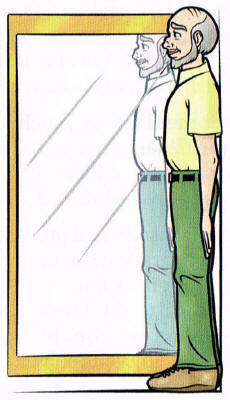
Good Posture Is Good for You
Posture is the way you hold your body. Poor posture can lead to neck
problems.
It keeps muscles from properly supporting the neck and puts pressure on
disks, ligaments and joints. As a result, injury and pain can occur.
Practice good posture to help keep your neck healthy and pain-free.
Poor Posture Hurts Your Neck
Many of us have poor posture. For some, it feels natural to hunch
over, thrust the chin forward
or slouch the shoulders. But doing these things puts a lot of stress and
strain on the neck.
Be sure to check your posture and change any poor posture habits that are
hurting your neck.
|
|
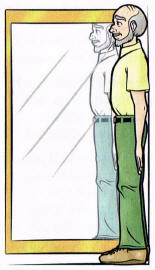

|
Checking Your Posture
Use a full-length mirror to help check your posture.
To begin, stand normally. Then slowly back up against
a wall. Is there space between your head and the wall?
Do you slouch your shoulders? Is your chin pointing up
or down? All these can cause neck pain and injury.
Improving Your Posture
Follow these steps to improve your posture:
●
Breathe deeply.
●
Pull your shoulders back.
●
Think of the ears, shoulders and hips as a series
of dots.
Now, adjust your body to connect the
dots in a
straight line.
●
Keep your chin level.
|
|
Goodbye Bad Body Mechanics
The way you move and position your body during daily activities is called
body mechanics.
Good body mechanics helps protect the neck. This means learning the
right ways to stand, sit, and even sleep.
So do what's best for your neck and say goodbye to bad body mechanics once
and for all.
|
Standing
To protect your neck while
standing:
●
Carry objects close to your body.
●
Keep your ears and shoulders in a line while
standing or walking.
●
To lower yourself, bend at the knees with a
straight back. Do this instead of
looking down and
reaching for objects.
●
Work at eye level. Don't reach above your head or
tilt your head back.

Sleeping
To protect your neck while sleeping:
●
Sleep on your back with a pillow under your knees,
or on your side with a pillow
between bent knees
to align the spine.
●
Avoid using pillows that are too high or too low.
Instead, use a neck roll or
pillow under your neck
while you sleep.
●
Sleep on a mattress that supports you, with a
pillow under your neck.
|

Sitting
To protect your neck while sitting:
●
Set up your workstation so your monitor is at or
below eye level. Also,
use a document holder
when viewing papers or books.
●
Keep your knees at or slightly below the level of
your hips.
●
Sit up straight, with feet flat on the floor. If feet
don't touch the floor, use a
footrest.
●
Avoid sitting or driving for long periods. Take
frequent breaks.
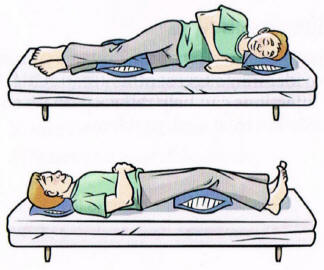
|
|
Treating
Neck Pain: Physical Therapy
If self-care
treatments aren't helping relieve neck pain, your
healthcare provider may suggest one or more sessions of physical therapy.
Medications or other treatments also can be helpful for treating neck
problems. |
|
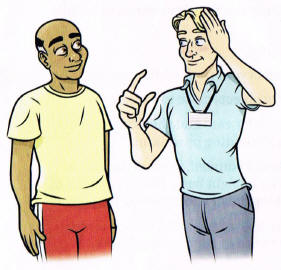
|
Physical Therapy for Your Neck
Physical therapy is performed by a specialist trained to treat injuries.
Your physical therapist (PT) will teach you how to strengthen muscles,
improve the spine's alignment and help you move properly.
Treatment methods used in physical therapy may include:
●
Heat.
A special heating pad called a neck pack
may be applied to your neck.
●
Exercises.
Your PT will teach you exercises to help
strengthen your neck and improve its range of
motion.
●
Joint
mobilization.
The PT gently moves your
vertebrae to help restore motion in your neck
joints and
reduce neck pain.
●
Soft tissue
mobilization.
The PT massages and
stretches the muscles in your neck and shoulders.
●
Electrical stimulation.
Electrical impulses are
applied to your neck. This helps reduce soreness
and inflammation.
●
Education
in body mechanics.
The PT shows you
ways to move your body that protect the neck.
|
Other Treatments
If physical
therapy doesn't relieve your neck pain,
your healthcare provider
may
suggest
other treatments.
For example, medications or injections can help
relieve pain.
In some cases, surgery may be needed to treat neck problems.
|
|
Exercises
for a Healthy Neck
When neck
muscles are strong, the neck is supported and can move naturally.
Below are examples of exercises you can do to strengthen and stretch your
neck muscles.
Move slowly as you exercise and don't force your neck into position.
And don't overdo it!
NOTE:
Do these exercises only if instructed by your healthcare provider.
Play It
Smart: Tips for Safe Neck Exercises
●
If you are recovering from a neck problem, do only the exercises
prescribed by your
healthcare provider. If instructed, do the
exercises in this article daily. You might
take 15 minutes in the morning and 15 minutes in the
evening.
●
Don't hold your breath during exercises. Breathe normally.
●
You may have some discomfort. But stop immediately if you feel pain,
tingling or
numbness, or if you feel dizzy, lightheaded or
sick to your stomach. Then talk to your
healthcare provider.
|
|
Range-of-Motion Exercises
Range-of-motion exercises stretch neck muscles. Gently do the
following exercises.
Never force your neck into position. |
|
Flexion
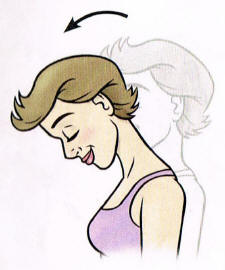
1.
Slowly drop your chin toward your chest. Only go
as far as is comfortable.
2. Hold for ........ seconds.
3. Return your head to the
starting position.
4. Repeat exercise ........ times.
|
Extension
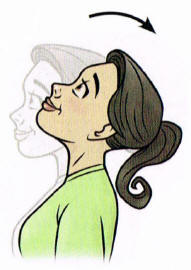
1. Gently tilt your head backward
as far as is comfortable.
2.
Hold for ........ seconds.
3. Return your head to the starting
position.
4. Repeat exercise ........ times.
NOTE: Only do this
exercise if instructed by
your healthcare
provider.
|
|
|
Rotation
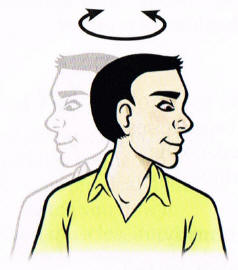
1. Slowly turn your head to the
right as far as is
comfortable.
2. Hold for ........ seconds.
3. Return your head to the center.
4. Now gently turn your head to the left and hold
for ........ seconds.
5. Repeat exercise ........ times
on each side.
|
Side Bend

1. Gently tilt your head toward
your left shoulder.
2.
Hold for ........ seconds.
3. Return your head to the starting
position.
4. Now slowly tilt your head toward the right shoulder
and hold for ........ seconds.
5. Repeat exercise ........ times.
|
Chin Glide
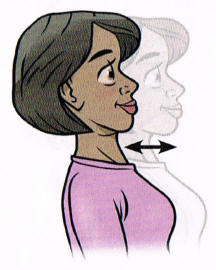
1. Hold your head and neck
straight.
2. Slightly tuck your chin into
your neck. Glide your
neck back so the ears are over the shoulders.
3. Hold
for ........ seconds.
4. Return your head and neck to the
starting position
and rest.
5. Repeat exercise ........ times.
|
Shoulder
Blade Squeeze
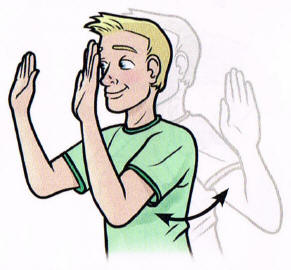
1. Lift your arms and bend your
elbows. The upper arms
should be at or just below shoulder level. Your palms
should face forward.
2. Slowly move your arms back,
squeezing your shoulder
blades together.
3. Hold
for ........ seconds. Relax.
4. Repeat exercise ........ times.
|
|
Isometric Exercises
Isometric exercises strengthen neck muscles. Do the following
exercises slowly.
Do not
force your neck into position. |
Forward Head
Press

1. Gently press your palms against
your forehead.
Push your head forward using the muscles in
your neck.
2. Hold for ........ seconds.
Relax.
3. Repeat exercise ........ times.
|
Backward Head
Press
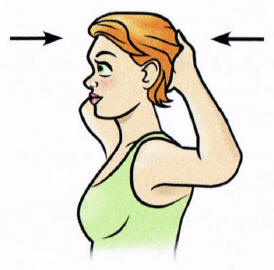
1. Gently press your palms against
the back of your head.
Push your head backward using the muscles in your neck.
2. Hold for ........ seconds.
Relax.
3. Repeat exercise ........ times.
|
Side Head
Press

1. Gently press your right palm
against the right side
of your head. Push your head sideways using the
muscles in your neck.
2. Hold for ........ seconds.
Relax.
3.
Repeat exercise ........ times.
4. Switch sides and repeat.
|
Rotation Head
Press
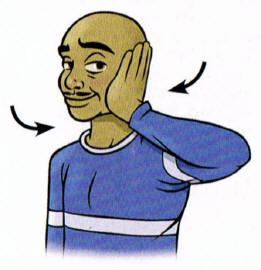
1. Gently press your left palm
against the left side of your head.
2. Resisting with the muscles in
your neck, gently try to turn
your head to your left. Do not allow your head or hand to
move.
3. Repeat exercise ........ times.
4. Switch sides and repeat.
|
Neck's Maintenance Guide
Do the following to promote good neck health:
●
Set up your computer monitor so that it's at or
below eye level.
●
Maintain neck health by practicing proper posture.
●
Move your head and neck only within a comfortable
range of motion. Use a headset to avoid
cradling
the phone with your neck and shoulder.
●
If you sit for long periods, take time to get up and
walk around.
●
Exercise daily to relieve stress and build strong,
supportive muscles.
●
Sleep on a mattress that supports your neck.
Avoid using pillows that are too high or too low.
And don't lie on your stomach.
●
If you smoke, quit. Your healthcare provider can
get you information about quitting.
●
Always talk to your healthcare provider about
concerns you may have about the health of your
neck.
|

|
|
Top of Page |



![]()
![]()